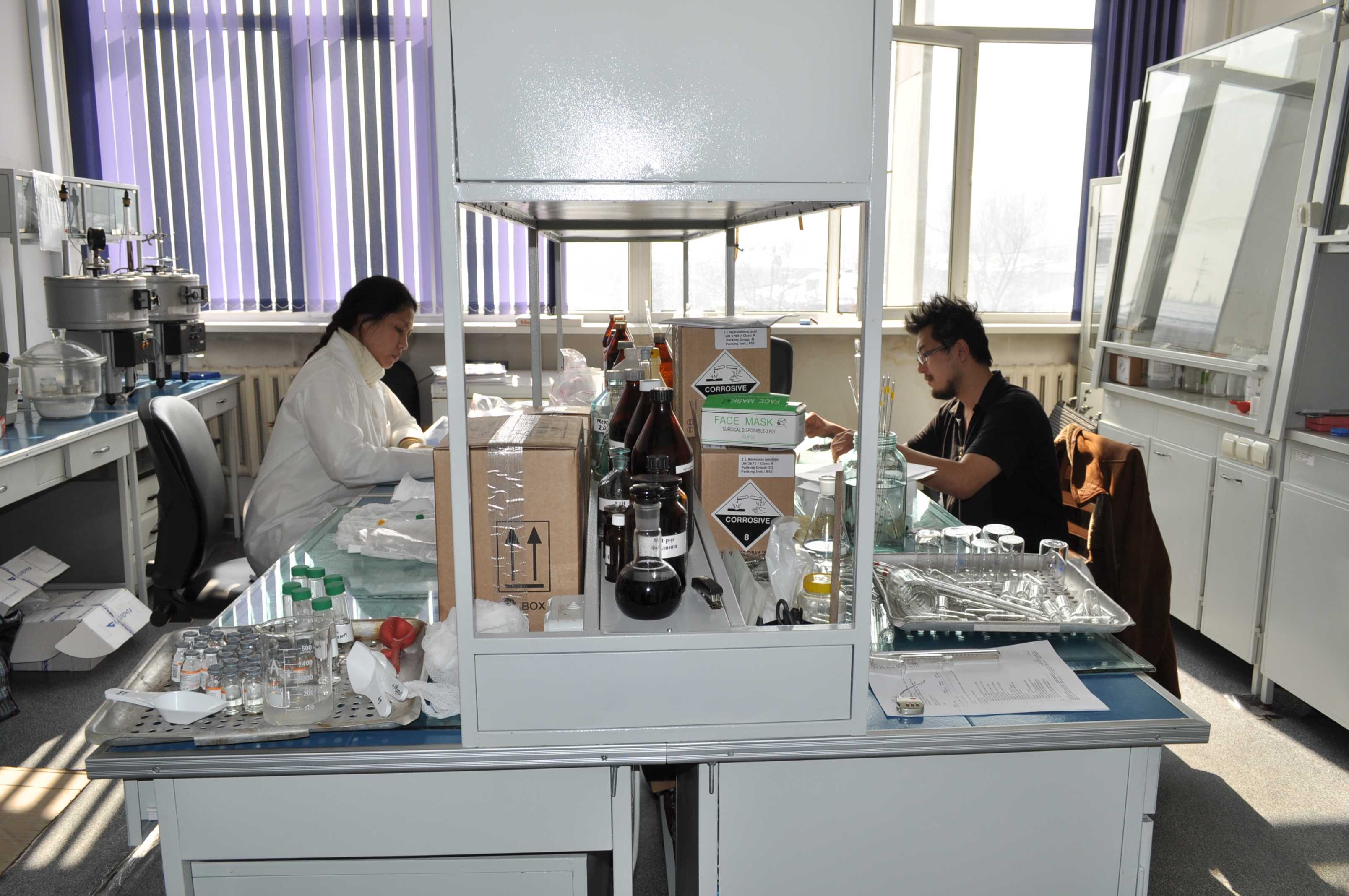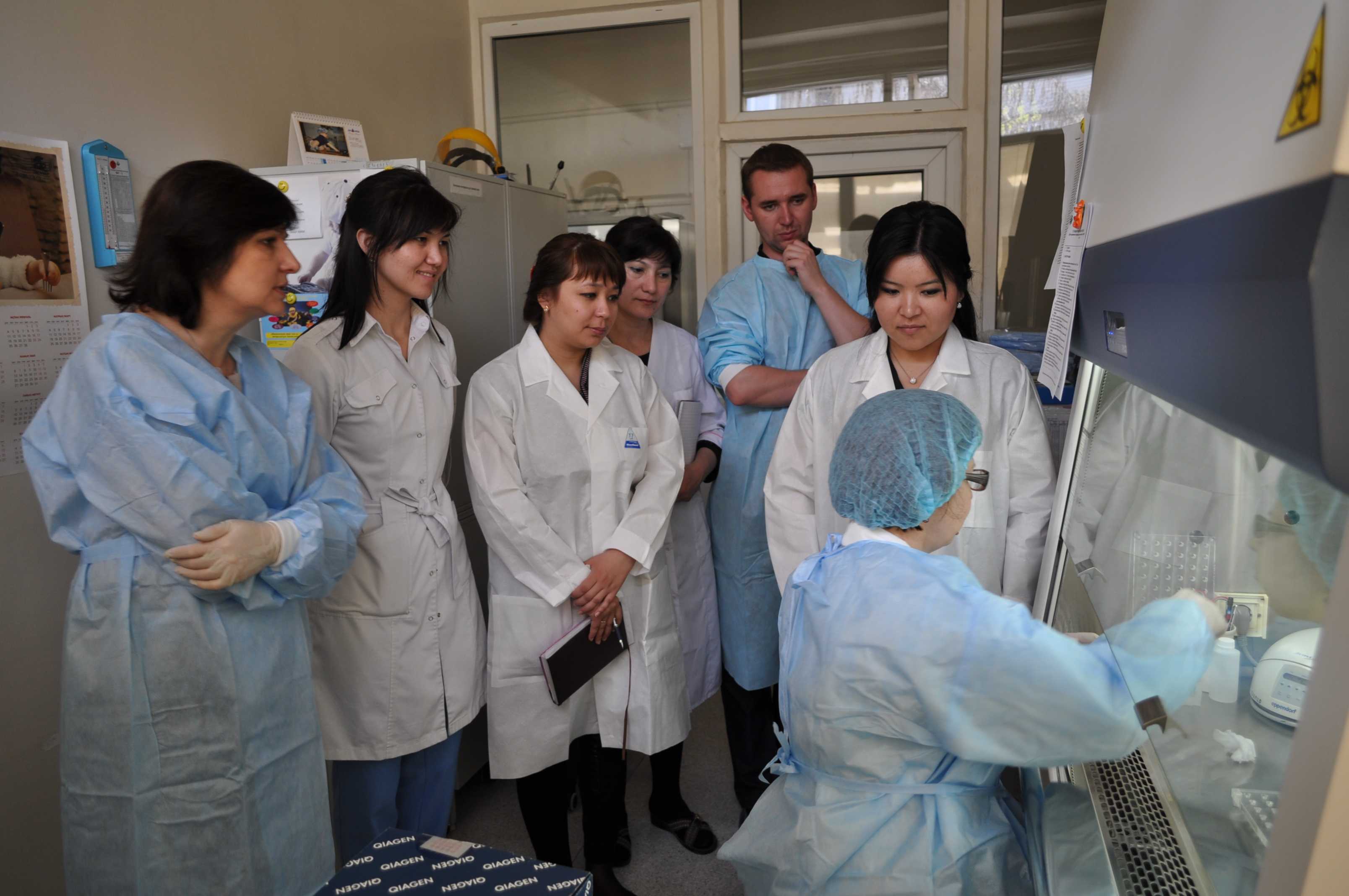Global Disease Detection Stories: Joining Forces on Laboratory Reform in Kazakhstan
A nationwide laboratory system capable of producing accurate, reliable, and timely results is one of the goals of the Global Health Security Agenda. As part of a large-scale project to modernize Kazakhstan’s laboratories, the Stepwise Laboratory Improvement Process is producing immediate, measurable results.
With dramatic landscapes, vast cultural diversity, and a wealth of natural resources, Kazakhstan is a country on the move. But under this promising landscape, deadly disease outbreaks like Crimean Congo Hemorrhagic Fever still occur and are of increasing concern. Quickly containing outbreaks requires cooperation between clinicians, epidemiologists, and laboratory technicians who accurately confirm a diagnosis through testing.

Kazakhstan lab specialists at a state laboratory in Almaty.
Kazakhstan is a large country with thousands of laboratories spread throughout government ministries and hospitals. However, after the fall of the Soviet Union, networks to support these laboratories faded and the labs were in need of crucial updates. Laboratory directors recognized the need to modernize their labs, and needed help coming up with a strategy for doing so. International guidelines and trainings provided generalized direction, but not step-by-step instructions in a local context.
Laboratories in need
One of these laboratories is located in Semey – a town on the steppe in Eastern Kazakhstan along the Russian-Siberian border. It is a clinical laboratory and, like so many laboratories across former Soviet republics, was designed in the 1950’s and needed updating to meet international laboratory standards. For example, inside the clinic, a doctor’s office was squeezed onto the same floor as three working laboratories. Specimens taken in the doctor’s office were carried across the patient waiting area to the adjacent laboratories. The doors to the laboratories had no locks or biohazard signs, so patients could wander in and out of the clinical laboratory where hazardous materials were stored. In the lab, a red line across the floor divided the clean area from the working area, which was confusing, especially to new staff. None of the laboratories had an eyewash station and most lab technicians were unaware of the requirement to have one.
Things needed to change.
Creating better systems
In 2014, the Ministry of Healthcare and Social Development began working on a large-scale project to modernize Kazakhstan’s laboratories alongside CDC and other international partners, together with a coalition of international partners, began working on a large-scale project to modernize laboratories. The goal was to introduce the Stepwise Laboratory Improvement Process for accreditation into a few selected laboratories. The Stepwise approach is a training and mentoring program developed by world experts to create immediate, measurable improvement in laboratories. The program is aimed at laboratory managers – teaching them how to implement a quality management system in their laboratories – and at revising government policies. The anticipated result: a network of modern labs that follow international laboratory standards and provide reliable and trustworthy results.
The Stepwise approach uses hands-on activities that are organized into training modules and implemented over 9-12 months. The ultimate goal is to change the way laboratory staff do their jobs every day, improving the quality of results. As Dr. Riza Ikranbegiin, one of the project organizers, acknowledged, “The laboratory staff had training in the past. The problem was that the trainings were not specific enough, not detailed enough. Most regulatory policy documents are written in academic language that people do not easily understand. They need practical, hands-on trainings that help them to interpret the documents and provide step-by-step instructions on how to apply the international standards and guidelines to improve their labs.”
Training the strongest laboratories
Over 15 months of Stepwise training, the five laboratories were transformed.
The Semey laboratory was one of five chosen to participate in the laboratory improvement project. As a requirement for participation, staff at the lab were already able to conduct tests on blood and urine samples for hepatitis, sexually transmitted diseases, diabetes, and some DNA testing, but needed assistance in modernizing safety and testing practices. All five laboratories went through the Stepwise approach. Staff attended three quality management workshops and participated in a six-week mentorship program.
Over the 15 months of the project, the five laboratories were transformed. Each laboratory, including the one in Semey, now has a designated quality manager and biosafety officer who teach staff how to implement quality control and biosafety requirements. The laboratories now have an actual wall (instead of the red line on the floor) that separates the clean area from the working area. These labs now sit on a separate floor from doctors’ offices. Locks and appropriate signage were added to the doors, and every lab now has at least one eyewash station.
Policy documents issued by the Kazakh Government were revised to define the roles and responsibilities of reference, clinical, and public health laboratories. Guidance was written to explain the regulations, and strategic plans were drafted defining step-by-step expectations for laboratory achievements in future years.
Teaching a few to teach many

The Stepwise process is aimed at laboratory managers.
Following these accomplishments, the Ministry of Health designated four of the five laboratories to serve as “expert” regional laboratories. One of the labs in Astana, the capital of Kazakhstan, became a “master” national reference laboratory.
The four regional laboratories offer targeted training to other facilities within their region, spreading improvement grassroots-style, one facility at a time. The five model laboratories understand what needs to be done in order to meet international standards and will spread this knowledge to other facilities.
Sustainability and continued collaboration
Kazakhstan now has a complete strategy to improve its laboratories. The CDC Central Asia Regional office continues to provide technical assistance to the government of Kazakhstan. Together with partners over the next several years, they will implement activities in the strategic plan, improve more laboratories, draft additional guidance documents, train the workforce, and realize new goals. For example, a robust electronic information system is needed in all laboratories; results are still recorded on paper. And tightening the relationship between laboratory technicians, clinicians, and epidemiologists is a work in progress.
Making better laboratories requires reaching across agencies and opening up communication channels between these three groups. As improvements are made across these sectors, the hope is that outbreaks of diseases like Crimean Congo Hemorrhagic Fever will become a thing of the past.
Policy into practice
As a result of this collaboration, the relationship between CDC and the government of Kazakhstan is stronger than ever, and the work on laboratories will result in a stronger public health system in Kazakhstan that can serve as a model for the entire region of Central Asia.
Progress in modernizing laboratories in Kazakhstan is thanks in part to support from the Centers for Disease Control and Prevention (CDC) Foundation to the Ministry of Healthcare and Social Development of Kazakhstan. This work is coordinated through the GDD Regional Center for Kazakhstan and Central Asia, which is part of CDC’s regional office. Kazakhstan is one of 30 U.S. partner countries named in the Global Health Security Agenda.
- Page last reviewed: December 11, 2015
- Page last updated: December 11, 2015
- Content source:


 ShareCompartir
ShareCompartir